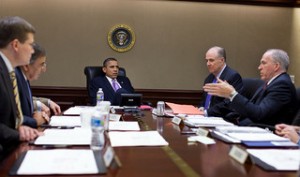The New Gitmo Memorandum of Understanding: Obama Finally Figured Out How to Close Down Gitmo!
Yesterday, the NYT weighed in on a new practice at Gitmo: the requirement that lawyers whose clients have lost their habeas case sign new memoranda of understanding governing the terms of access to their client.
The Obama administration’s latest overuse of executive authority at Guantánamo Bay is a decision not to let lawyers visit clients in detention under terms that have been in place since 2004. Because these meetings pose little risk and would send a message about America’s adherence to the rule of law, the administration looks as if it is imperiously punishing detainees for their temerity in bringing legal challenges to their detention and losing.
[snip]
Four years after the Supreme Court ruled that “the privilege of habeas corpus entitles the prisoner to a meaningful opportunity to demonstrate that he is being held pursuant to ‘the erroneous application or interpretation’ of relevant law,” the government may be calculating that it can decide what “meaningful” means.
But if the wars where detainees were captured have been to defend American interests, surely the country has an interest in an unequivocal commitment to the rule of law, including full legal representation for detainees.
The NYT got closer to ascribing a motive and envisioning the impact of the policy than Lawfare’s several posts on the subject. But I think both are missing what I suspect is the point.
Aside from giving detainees little recourse over issues affecting their own treatment (which is most urgent, in my opinion, to monitor the mental health of the detainees), the MOU will have three effects:
- Gutting Obama’s own promise to provide Periodic Reviews to detainees
- Eliminating the risk that detainees will pursue justice internationally
- Burying Obama’s biggest failed promise
Gutting the Periodic Review Boards
As Jack Goldsmith reminded back in April, a year earlier Obama had issued an executive order promising a Periodic Review Board for all detainees.
In March 2011, the Obama administration issued an Executive Order (13567) that created a process of Periodic Review of Individuals Detained at Guantánamo Bay Naval Station Pursuant to the Authorization for Use of Military Force.” The “review and hearing” process was designed to operate on top of the habeas review process and the other internal review processes for GTMO detainees, and to facilitate release of detainees who were not “a significant threat to the security of the United States.” Bobby analyzed the EO here and here, as did Tom Nachbar here.
The EO states: “For each detainee, an initial review shall commence as soon as possible but no later than 1 year from the date of this order” (emphasis added). I have heard little about these reviews since last Spring, and the deadline for their commencement passed last month. Has the administration carried out its pledges under the EO?
Irrespective of the delay, it was crystal clear by April that Obama didn’t put much stock in his promise to tie continued detention to the risk a detainee posed. After all, the Administration was willing to gut habeas with a detainee who, on multiple occasions, under both the Bush and Obama Administration, was cleared for release. When Obama did release the PRB guidelines, the timing involved–providing for just 4 months of election season during which the PRB would function (one of which has already elapsed)–made it clear it wasn’t actually supposed to function.
But the whole thing is supposed to be driven by new information; it’s not a reconsideration of information already in the files. And not only does the PRB determine the priority in which they’ll consider cases, they get to decide whether any information from the detainee is relevant.
Any additional relevant information (as defined in the Glossary) that has become available since the later of the Reference (k) review or prior PRB review, including information discovered as a consequence of information presented by the detainee’s personal representative or private counsel.
[snip]
(1) The personal representative and private counsel, if any, shall be provided with advance notice of the PRB review, as well as a reasonable opportunity to meet or talk to the detainee to discuss the PRB process and the information the detainee may wish to submit.
(2) The personal representative and private counsel, if any, may prepare a written submission for the PRB, which may include a written statement from the detainee. The written submission shall include all factual information that the detainee intends to present in the PRB proceedings. Such submission shall only contain information relevant and material to the determination of whether continued law of war detention of the detainee is necessary to protect against a continuing significant threat to the security of the United States. Relevance of the information is determined by the PRB.
And now the MOU warns that lawyers cannot assist their client for PRB matters under the MOU. Read more →


